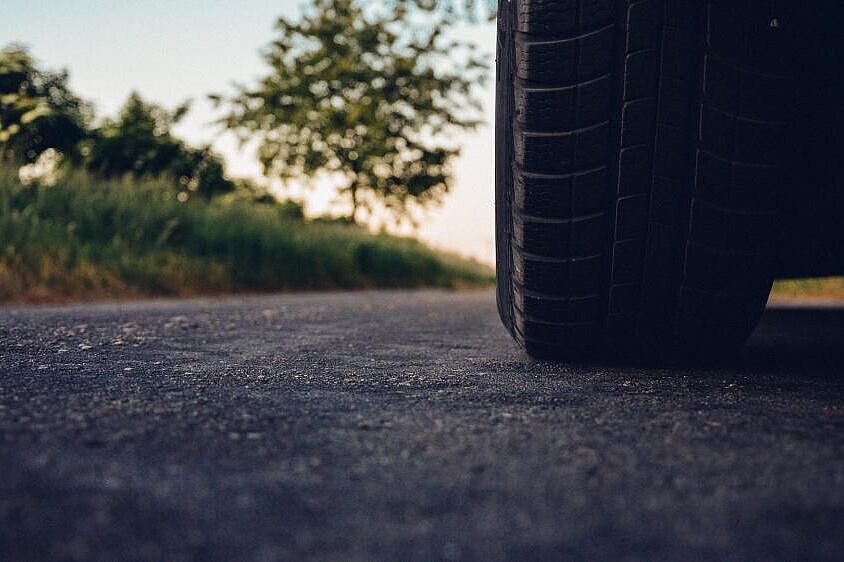Tires abrade fine particles when driving.

Example photo: Car tires are made of more than just rubber. Many of the components are toxic. | Photo: tookapic_pixabay
These contain a complex mixture of different compounds, including toxic substances: heavy metals such as cadmium and zinc and organic substances such as the ozone protection or antioxidant 6-PPD. If the tire wear particles end up in freshwater ecosystems, the pollutants are leached out there. A new review article in the Journal of Environmental Management summarises the current state of knowledge on the occurrence of tire wear particles and the release of pollutants in aquatic ecosystems. The researchers warn of the toxic effects on aquatic organisms and associated ecological consequences.
Tire wear particles enter rivers and lakes primarily via wind and rain. These particles account for 50 to 90 per cent of all microplastics that run off roads during rainfall. Furthermore, scientific extrapolations suggest that nearly half (45%) of the microplastics found in soil and water come from tire abrasion. The concentration of tire wear particles in water bodies can vary by several orders of magnitude, ranging from 0,00001 to 10.000 milligrams per liter.
In this article in the Journal of Environmental Management, the authors analyse existing studies on the effects of tire wear particles on aquatic organisms, providing an overview of possible ecological consequences. "The problem with tire abrasion is not only the particles themselves, which remain in the environment for a long time and behave like other microplastics, but also the leaching of toxic additives", said Prof. Hans-Peter Grossart, researcher at IGB and co-author of the review study.
It's not just rubber: of the more than 2,400 chemicals present, at least 140 additives are leached out
After all, car tires are made up of more than just rubber. In fact, 2,456 chemical compounds were identified in tire rubber, 144 of which are present in the leachates. These include organic pollutants such as hexa(methoxymethyl)melamine, dibutyl phthalate, and N-(1,3-dimethylbutyl)-N′-phenyl-p-phenylenediamine (6-PDD) and its derivative, 6-PDD-quinone. In addition, there are heavy metals such as zinc and manganese in considerable quantities, as well as cadmium and lead. These substances are used for ozone protection, as antioxidants or plasticisers, and as vulcanising, reinforcing and filling agents. "During the leaching process, tire abrasion releases more chemicals than thermoplastics such as PE. We also assume that more substances are leached out than we already know", said Hans-Peter Grossart.
Harm to organisms and ecosystems
The particles and their leaching can promote the formation of free radicals (oxidative stress) in organisms, cause genetic changes and alter their immune response. At the individual level, they can affect feeding behaviour, reproduction and survival.
The study also highlights the broader consequences for the structure and function of ecosystems aiming to bridge the gap between toxicological responses in living organisms and ecosystem-level processes. At the ecosystem level, particles cause shifts in species composition, reducing aquatic biodiversity and altering the food web. As a result, they significantly impact the carbon and nitrogen cycles, thereby altering essential processes such as biomass formation and nutrient availability.
However, toxicity studies are often carried out under laboratory conditions and can only be transferred to natural ecosystems to a limited extent. Firstly, the interactions in nature between inanimate matter and living organisms are more complex. Secondly, higher concentrations are usually used in laboratory experiments than are actually relevant in the environment. Nevertheless, the authors recommend taking the dangers of tire abrasion seriously.
Hans-Peter Grossart added, "Global environmental changes such as warming and acidification will also exacerbate the effects of tire wear and its leaching by altering its toxicity and its interactive effects on microbial activity, nutrient cycling and the resilience of ecosystems."
Reduction of tire abrasion into natural systems
Several studies have looked at how tire abrasion is spreading in the environment. Although it is also transported by wind, it usually accumulates in the immediate vicinity of its source, particularly in sediments and water catchment areas adjacent to pollution hotspots such as busy roads and artificial pitches. The researchers estimate that only around two per cent of all abrasion particles from rivers reach the coastal zones. "The fact that these particles are often not very mobile offers potential for better prevention", explained Hans-Peter Grossart. "Effective reduction strategies involve the development of alternative tire manufacturers, and a better demarcation of roads and wastewater from natural areas. Ultimately, everyone can make their own contribution with a prudent driving style."
Tire wear particles in aquatic environments: From biota to ecosystem impacts
Wenjuan Song; Li Lin; Seungdae Oh; Hans-Peter Grossart; Yuyi Yang
Journal of Environmental Management. - 388(2025), Art. 126059
http://dx.doi.org/10.1016/j.jenvman.2025.126059
Januar 2025
Yousuf Dar Jaffer; Fazel Abdolahpur Monikh; Klümper Uli; Hans-Peter Grossart
Environmental Research. - 263(2024)3, Art. 120187






